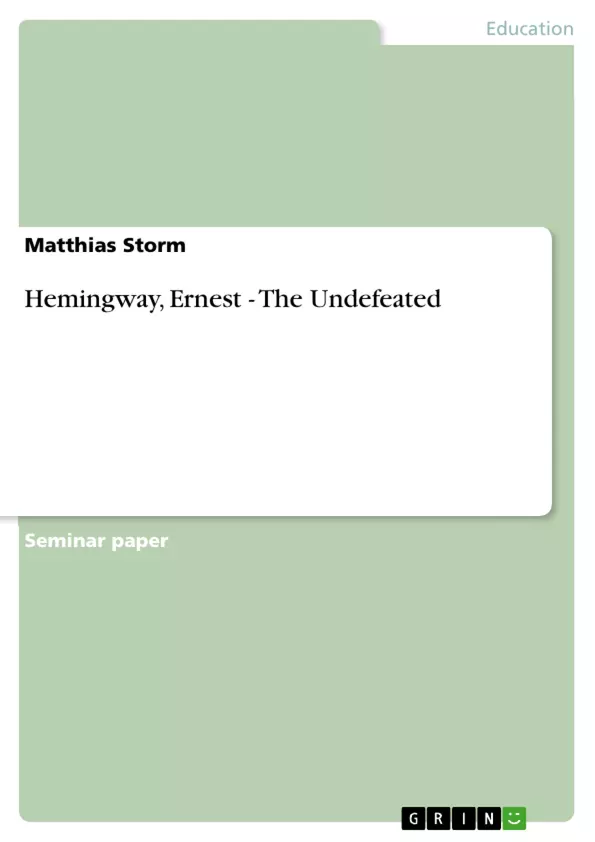Stories are the oldest forms of literature. They found their first expression in the classical tales of the Old Testament.
In recent times stories have taken a broader form than during the 18th and 19th century, when the literary form of the novel and poetry prevailed.
The 20th century has discovered new possibilities and in connection with it: a new interpretation of human character.
This essay deals with theme and structure of Ernest Hemingway’ s “The Undefeated”. In particular it describes the story and the main theme. Furthermore it gives a characterisation of Manuel Garcia, illustrates the pecularities of Hemingway’ s style and introduces the bullfight as subject matter. It deals with “The Undefeated“ as a model for Hemingway’ s “The Old Man and the Sea“.
The ideas of this essay are thematically linked. The second chapter looks at general aspects. It is an introduction into the biography of Ernest Hemingway and retells the story of “The Undefeated”. In the main part (third chapter) the themes mentioned above are examined. Results are drawn in the fourth chapter. After that in the appendix references are given.
Table of Contents
- I. Introduction
- Stories are the oldest forms of literature
- The 20th century has discovered new possibilities
- This essay deals with theme and structure of Ernest Hemingway's "The Undefeated"
- II. General Aspects
- 1. Biography of Ernest Hemingway
- 2. The Story of "The Undefeated"
- III. Main Part
- 1. The Main Theme
- 2. The Characterisation of Manuel Garcia
- 3. Peculiarities of Hemingway's Style in "The Undefeated"
- 4. The Bullfight as Subject Matter
- 5. "The Undefeated" as a Model for Hemingway's "The Old Man and the Sea"
- IV. Results
- V. Appendix
- 1. References
Objectives and Key Themes
This essay examines the theme and structure of Ernest Hemingway's short story "The Undefeated." It explores the main theme, provides a characterization of the protagonist, Manuel Garcia, analyzes Hemingway's writing style, and examines the bullfight as subject matter. The essay also discusses "The Undefeated" as a model for Hemingway's later work, "The Old Man and the Sea." The essay aims to provide a deeper understanding of the story's themes and significance.
- The main theme of the story
- The characterization of Manuel Garcia
- The peculiarities of Hemingway's style
- The bullfight as subject matter
- "The Undefeated" as a model for Hemingway's later work
Chapter Summaries
I. Introduction
The introduction provides a brief overview of the evolution of storytelling, highlighting its historical context and the changing interpretation of human character in the 20th century. It outlines the essay's focus on Ernest Hemingway's "The Undefeated," specifically addressing the story's theme, structure, and main character, Manuel Garcia. It also mentions the analysis of Hemingway's style and the bullfight as a subject matter, concluding with the exploration of "The Undefeated" as a model for "The Old Man and the Sea." The introduction also establishes the thematic connections between the essay's chapters.
II. General Aspects
1. Biography of Ernest Hemingway
This section presents a concise biography of Ernest Hemingway, highlighting his early life, career as a journalist, and literary achievements. It mentions his early works, including "In Our Time," "The Torrent of Spring," and "The Sun Also Rises," and the publication of "The Undefeated" in "Quarterly" magazine. The section also acknowledges Hemingway's later works and their widespread reception, contrasting it with the relatively lesser attention paid to "The Undefeated" in recent times.
2. The Story of "The Undefeated"
This section provides a summary of the story's plot. It follows Manuel Garcia's journey from his encounter with Don Miguel Retana, who offers him a bullfight, to his meeting with Zurito, the "picador," who reluctantly agrees to help him. The summary then depicts the events leading to the bullfight, highlighting the tension and anticipation surrounding the fight. It also includes details about the setting, the characters, and the bull's behavior during the fight.
III. Main Part
The main part of the essay, divided into five sections, will delve into the core themes, arguments, and narrative elements of the story "The Undefeated." It will explore the main theme, provide a characterization of Manuel Garcia, analyze the peculiarities of Hemingway's style, examine the bullfight as subject matter, and discuss the story's significance as a model for Hemingway's later work, "The Old Man and the Sea." The essay's conclusion will be excluded from this preview to avoid spoilers.
Keywords
The main keywords and focus topics of the text include Ernest Hemingway, "The Undefeated," short story, theme, structure, characterization, Manuel Garcia, Hemingway's style, bullfight, subject matter, "The Old Man and the Sea," and literary critique. These keywords represent the primary terms and concepts explored in the essay, highlighting the analysis of Hemingway's short story and its literary significance.
- Citar trabajo
- Matthias Storm (Autor), 2003, Hemingway, Ernest - The Undefeated, Múnich, GRIN Verlag, https://www.grin.com/document/19115



